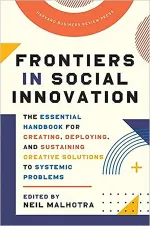Edited by Neil Malhotra
Social innovation is the process of developing and deploying effective solutions to challenging and systemic social and environmental issues in support of social progress. Over the past twenty years, mission-driven for-profit companies, as well as newer organizational forms (such as benefit corporations and companies certified as B Corporations), have emerged as powerful drivers of social change. In tandem with the diversification of organizational forms, impact investing funds — as well as traditional sources of money such as venture capital — have helped fuel the social innovation engine. Further, nonprofits have begun to explore more creative earned revenue-based business models. The field has become more disciplined, centering on three core concepts: theory of change, impact measurement, and design thinking. But important questions have remained and new ones have emerged that social enterprises, impact investors, philanthropists and foundations, and nonprofit and government leaders will be forced to grapple with.
This volume brings together leading academics, practitioners, thinkers, and leaders who teach courses as part of the Certificate in Social Innovation and Public Management at Stanford Graduate School of Business. It serves as both a handbook of long-standing existing knowledge and a discussion of issues on the frontier of social innovation. As such, it is intended for a diverse audience, both newcomers and veterans to the space. The key lessons and insights are valuable for students embarking on their careers, as well as seasoned executives wondering how to incorporate social innovation into their traditional for-profit business models. The volume touches on all aspects of the social innovation universe: philanthropy, nonprofits, social entrepreneurship, impact investing, public-private partnerships, and corporate social responsibility. The book progresses logically, from high-level foundational material to frameworks, to tactics, and finally to case examples that shine a light on all the aspects of social innovation discussed up to that point.
Upon completion of this volume — grounded in the social innovation curriculum that Stanford GSB is famous for — readers should have both a strong grasp of long-standing frameworks and concepts of social innovation as well as an understanding of the future challenges on the horizon and the opportunities available to make a real and meaningful difference, improving lives, organizations, and the world.
